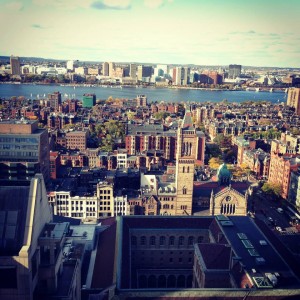As things go in life, my schedule did not allow me to visit my previous reflection spot. But don’t be too concerned, I was out and about having fun in Boston! As soon as the plane lifted off from Richmond International Airport, I realized that I’d be entering into a different major watershed for the first time this year. Boston’s Charles River does not flow into the Chesapeake as the Potomac, Anacostia, Shenandoah, James, Susquehanna, etc. do.
Over the course of the flight as I was getting closer and closer to the Charles River, I got a bird’s eye view of the DelMarVa peninsula. As we discovered from looking at aerial maps while out on the Potomac, there were agricultural sites everywhere. From that height, it was easy to tell that the water changes when close to urban, agricultural, riparian, and/or coastal area. The flow out from urban areas without buffers in the Chesapeake Bay was a starkly different color from the water further out in the ocean. I also noted the amount of grey vs. green vs. yellow spaces distributed on the land as we discussed in relation to the University of Richmond campus in class. Colors can tell us a lot about the environment! Needless to say, I’ve never paid this close attention to bodies of water while in a plane in my life. It was a great way to live what I learn, and I plan to be this observant during all of my domestic and foreign travels.
After the flight, the group I was traveling with headed to our hotel, the Westin at Copley Place. I walk into my room on the 25th floor and gasp. The view out of the window is astonishing – old churches mixed with modern skyscrapers lead my eye out to the beautiful blue waters of the Charles. White sailboats scattered the water as a regatta was taking place. This view of the Charles was astonishing and I felt privelaged to live in that room for the next two days because of it.
Here are some basic facts about the Charles River:
– it is fed by 80 streams
– it is 80 miles in length
– its watershed contains 8000 acres of protected wetlands
– Captain John Smith originally named it the “Massachusetts River” after the Native American tribes living in that part of New England. However, King Charles the First decided he wanted it named after him rather than some “barbarous name”. Great guy, right?
While in Boston I kept wondering about the water quality of the river and what kinds of biodiversity existed in the Charles. Cue research mode. On the internet I got tons of great information. Apparently the Charles River Conservancy has been working towards levels of water quality that would allow public swimming. Public swimming was outlawed in the 1950’s when the extent of degradation of the water was made apparent to lawmakers. In recent years the water quality has improved from a D rating to a B+ rating, so now experts are working on making the Charles more accessible so people can enjoy the restored water. I am intrigued at getting to know yet another river in a watershed outside of our own. The knowledge and perspective from class is starting to color my life. One thing is for certain: I still have more research to do.

